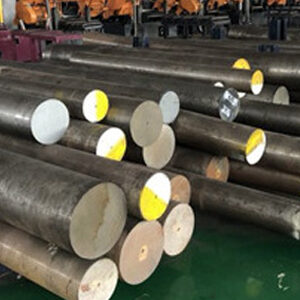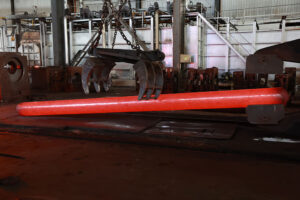Unraveling Corrosion Resistance in Tool Steel
 Tool steels perform in some of manufacturing’s harshest environments. Acids, caustics, high temperatures, and corrosive atmospheres degrade tools and dies over time. While corrosion resistance is not their primary quality, understanding how tool steels combat corrosion can help select grades and treatments to extend service life.
Tool steels perform in some of manufacturing’s harshest environments. Acids, caustics, high temperatures, and corrosive atmospheres degrade tools and dies over time. While corrosion resistance is not their primary quality, understanding how tool steels combat corrosion can help select grades and treatments to extend service life.
In this article, we’ll unravel the factors that influence corrosion in tool steels. Learn how composition, heat treating, coatings, and maintenance impact corrosion resistance. Discover methods for comparing and testing different tool steel grades. With science-backed knowledge, engineers can choose optimized tooling solutions for their specific corrosion challenges.
An Introduction to Tool Steel Corrosion
Corrosion refers to the gradual degradation that occurs when tool steels chemically react with environments containing water, acids, bases, salts, or other electrolytes. The resulting oxidation destroys the desired steel properties and dimensions.
Tool steels are inherently corrosion-prone due to their high iron and carbon content. However, intelligent alloy and heat treat selection produces grades with useful corrosion resistance for many applications. Understanding corrosion mechanisms is key to mitigating damage.
Oxidation and Passivation
Corrosion occurs via an electrochemical process called oxidation. Iron in the steel reacts with water or salt to form iron oxide compounds known as rust or scale. This destroys the tool surface and dimensions.
However, adding certain alloying elements can produce a micro-thin passive oxide layer that shields the bulk steel from further corrosion. Elements like chromium, nickel, and silicon enhance formation of this protective barrier.
Balancing composition and heat treating optimizes the stable passivation layer while retaining needed hardness, strength, and toughness.
Common Corrosive Environments
Tool steels encounter diverse conditions that impact corrosion rate including:
Acids and Bases
Mineral and organic acids corrode through direct chemical attack. Solutions containing chlorine, sulfur, or nitric compounds are especially aggressive. Caustics like sodium hydroxide also degrade surfaces.
Aqueous Solutions
Water, steam, and humidity provide the electrolyte for electrochemical oxidation. Salts like chlorides accelerate corrosion in wet environments.
Gaseous Atmospheres
Gases including sulfur dioxide, ammonia, and hydrogen sulfide corrode through absorption and acid formation on the steel surface.
High Temperatures
Heat accelerates chemical reactions promoting oxidation, scaling, and inward diffusion of contaminants.
Understanding the unique corrosion mechanisms of each environment allows selecting tooling compositions and treatments that resist degradation.
Factors That Influence Corrosion Rate
The rate of corrosion depends on multiple interacting factors:
Temperature
Higher temperatures exponentially increase corrosion through accelerated reaction rates and diffusion.
Time of Exposure
Longer exposure grows passive films but extended contact enables pitting, crevice, and intergranular attack.
Surface Condition
Polished finishes resist corrosion better than ground tooling. Contaminants and tool wear accelerate localized corrosion.
Concentration of Electrolytes
Higher purity water and acids corrode slower than concentrated solutions or brine. Dilution and pH control can slow reactions.
Alloy Composition
Elements like chromium, molybdenum, nickel, and cobalt improve passivation layers and inhibit diffusion of contaminants.
Microstructure
Fine, uniform microstructures enhance corrosion resistance. Carbides and second phases can increase galvanic potential differences.
Residual Stresses
Tensile stresses promote crack initiation and acceleration. Compressive stresses slow crack growth.
Balancing those interacting factors through tool steel selection, heat treatment, and maintenance is key to managing corrosion damage.
Tool Steel Grades and Corrosion
The most corrosion-resistant tool steels derive their properties from chromium, nickel, and molybdenum content. Common corrosion-resistant grades include:
- Stainless steels – Contain at least 12% chromium for passivation, along with nickel and molybdenum. Grades like 440C and 420 have excellent corrosion resistance.
- Maraging steels – Nickel-cobalt alloys with chromium additions. Grades like C300 and C350 offer a balance of strength and corrosion resistance.
- Hot work die steels – H11 and H13 have 3-5% chromium to deter oxidation and nitriding. Hot work tooling sees constant heating cycles.
- Cold work tool steels – D2 contains 1% chromium and molybdenum for moderate corrosion resistance during cold forming and stamping.
- Mold steels – P20 and P30 alloys utilize chromium to resist moisture and release agents during molding.
Understanding the corrosion behavior of various tool steel families helps select grades optimized for expected exposure conditions.
Heat Treating Effects
While composition influences corrosion resistance, heat treatment also affects behavior through its impacts on carbide formation, grain structure, and residual stresses:
- Carbide types, size, and distribution affect galvanic potentials and crevice corrosion. Fine vanadium and tungsten carbides improve resistance.
- Fine, uniform austenite grain size improves passivation layer quality and reduces micro-galvanic couples.
- Compressive stresses counteract crack initiation. Stress relieving improves resistance.
- Tempering reduces carbon available for carbide formation. Over-tempering though weakens the matrix and corrosion resistance.
- Optimal quench and temper maximizes hardness while retaining fine microstructures. Interrupted quenching can increase tensile stresses.
Careful heat treatment balances the many factors governing corrosion rate.
Comparing Laboratory Corrosion Testing
Evaluating tool steel corrosion resistance requires standardized laboratory testing. Common methods include:
- Immersion testing – Samples are immersed in a solution and weighed periodically to determine mass loss corrosion rate.
- Electrochemical testing – Applied voltages measure the current needed for oxidation reactions to quantify corrosion rate.
- Salt spray testing – Tool steel samples are exposed to a corrosive fog and inspected periodically for cracking and pitting.
- Stress corrosion testing – Applying stresses during exposure reveals tendencies for environmentally-assisted cracking.
- High temperature testing – Elevated temperature testing accelerates attack mechanisms.
Test results offer comparative data when selecting tooling materials. However, actual service lives depend greatly on application conditions and maintenance.
Applying Protective Coatings
Surface treatments and coatings provide another line of defense against corrosion:
Nitriding
Diffusing nitrogen into the steel surface creates hard nitride phases. This improves wear and corrosion resistance. Common for dies, molds, and cutting tools.
Chrome Plating
Electrolytic chrome plating deposits a thick chromium layer for stainless-like protection. Used for food industry molds and acidic environments.
Titanium Nitride (TiN)
Extremely hard ceramic coating applied via PVD vapor deposition. Provides wear protection and lubricity. Popular for cutting tools and forming dies.
Nickel-Boron
Electroless nickel alloy coating offers excellent corrosion protection combined with lubricity and hardness.
Understanding coating properties allows selecting solutions tailored for tool steel corrosion prevention.
Corrosion Protection Strategies
A holistic approach combines protective measures:
- Select inherently corrosion-resistant tool steel grades and heat treatments
- Apply protective coatings like nitriding or electroless nickel
- Utilize corrosion inhibitors and rust preventatives during storage
- Keep tools dry when not in use
- Clean and remove accumulated scale and residues after cycles
- Polish away microscopic corrosion pits to restore surfaces
- Avoid galling and surface damage that increase corrosion
Layered protection maximizes the corrosion resistance and service life of tool steel components.
Emerging Tool Steel Corrosion Solutions

Ongoing tool steel research targets new alloys and treatments to improve corrosion resistance:
Reducing Cobalt Content
Cobalt is linked to health concerns. New tool steels minimize cobalt while still offering heat and corrosion resistance through additions of silicon, nickel, and manganese.
Graphene Coatings
Graphene’s impermeability may unlock ultra-thin anticorrosion coatings on tool steels. The material could shield against moisture and contaminant diffusion.
Corrosion-Resistant Microstructures
Novel heat treatments and alloying produce tool steel microstructures resistant to intergranular corrosion even at high temperatures.
Surface Modification
Hybrid tool steel composites with corrosion-resistant carbides or ceramics dispersed at the surface could combine bulk and surface benefits.
Corrosion Mapping
Advanced imaging and data analytics may identity microstructural corrosion risks to optimize tool steel processing. This could reduce failures and extend service.
Innovations will yield tool steels with corrosion solutions built-in by design rather than just mitigated through secondary processing.
Key Takeaways on Tool Steel Corrosion Resistance
- While not impervious, tool steels can be tailored for useful corrosion resistance through thoughtful alloy and heat treat selection.
- Oxidation is driven by electrolytes creating local electrochemical cells that destroy the steel’s surface. Passivation layers inhibit attack.
- Temperature, time, surface finish, alloy content, microstructure, and residual stresses all impact corrosion mechanisms and rate.
- Common tool steel families like stainless, maraging, hot work, and cold work grades offer a balance of corrosion resistance and mechanical performance.
- Coatings like nitriding and electroless nickel provide supplemental protection on high wear areas of tools.
- Emerging options like reduced-cobalt alloys, graphene coatings, and microstructure control aim to further improve corrosion resistance.
With science-backed understanding of causes and solutions, engineers can effectively manage corrosion and extend the reliable service life of tooling.
FAQ
What factors influence corrosion rate in tool steels?
Key factors that impact tool steel corrosion rate include:
- Temperature of exposure
- Concentration of salts, acids, bases, and contaminants
- Duration of contact with corrosive environments
- Alloy composition and microstructure characteristics
- Surface finish and residual stress state
- Use of protective coatings or inhibitors
How can heat treating improve tool steel corrosion resistance?
Proper heat treatment can enhance corrosion resistance by:
- Producing fine, uniform carbide sizes and distributions
- Generating compressive surface stresses
- Optimizing tempering to balance hardness and toughness
- Achieving a homogeneous microstructure and fine grain size
- Avoiding overheating that increases carbide precipitation
What corrosion resistant tool steel grades are available?
Some inherently corrosion-resistant tool steel grades include:
- Stainless steels like 440C, 420, and 17-4PH
- Maraging tool steels like C300 and C350
- Hot work tool steels alloyed with chromium (H11, H13)
- Mold steels containing chromium for polishability (P20)
- Cold work grades with chromium and molybdenum additions (D2)
How can coatings improve tool steel corrosion resistance?
Popular tool steel coatings that also increase corrosion resistance:
- Nitriding to create surface hardening
- Electroless nickel-boron for lubricity and chemical resistance
- Titanium nitride (TiN) for enhanced surface hardness
- Chrome plating for stainless-like qualities
What strategies can improve corrosion resistance during tool steel machining?
Tips to combat corrosion during tool steel machining:
- Select inherently corrosion-resistant alloys and microstructures
- Utilize high performance cutting fluids and corrosion inhibitors
- Prevent accumulated chips and debris from prolonged contact
- Rinse parts frequently to remove corrosive residues
- Dry thoroughly after washing to prevent humidity corrosion

